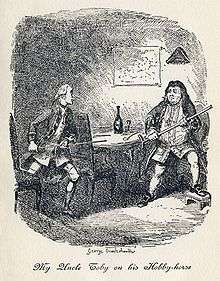Hobby horse polo
| Characteristics | |
|---|---|
| Team members | 6 per side |
| Mixed gender | Yes |
| Type | ball game, team sport, outdoor |
| Equipment | Ball, stick, hobby horse, sherry |
| Venue | Polo field (grass) |
| Presence | |
| Country or region | Germany |
| Olympic | No |
Hobby horse polo (German: Steckenpferdpolo) is a mixed team sport played on hobby horses. It is similar to other polo variants, such as canoe polo, cycle polo, camel polo, elephant polo, golfcart polo, Segway polo, auto polo and yak polo, in that it uses parts of the polo rules, however it has its own specialities.
Origin
Hobby horse polo originated in 1998 as a mockery of "polite society" in Heidelberg-Neuenheim, which led in 2002 to the foundation of the First Kurfürstlich-Kurpfälzisch Polo-Club in Mannheim. It has since become a trendy sport with various teams in German cities and gained some notoriety in the press.[1] [2] [3]
Playing polo with hobby horses has been described as a children's game in classical polo regions.[4] Hugh van Skyhawk,[5] an Indologist and professor of Islamic studies in Mainz and Islamabad, described hobby horse polo played by young boys as part of the ceremonies of the traditional Gindni (harvest preparations) festival in Hispar.[4]
In 2013 the Grütlihüüler Guggenmusik from Allenwinden (Baar, Switzerland) organized the first Steckenpferdpolo on Swiss soil.[6]
Rules

The objective is to score goals against an opposing team. The goals are traditionally marked by bar stools in width and height, but simple street hockey goals can also be used.[7] Players score by driving a small soft baseball into the opposing team's goal using a long-handled croquet mallet. A full match takes six 6-minute-long chukkas (periods) and each team may consist of six persons (depending of the size of the field and amount of interest). The minimum size of the field is 30 m (100 ft) long and 15 m (50 ft) wide. A 'last man' rule applies, as any player may act as goalkeeper.[7] As players need some protection against possible injuries, cleated shoes and shin guards are recommended. The mallets should be stable and are often taped to reduce the risk of losing the hammer head. It is preferred to hit the ball, but not other players.[7]
Each game starts with the teams in line behind their own goals and the ball in the midfield. On the umpire's command "Polo go", the teams gallop against each other, in one hand their mallets, in the other their hobby horses, which have to be led between the legs of the player. It is not allowed to kick or stop the ball by foot.[7]
Fouls or failures to gallop or to listen to the umpires are treated by a "punitive sherry" (variously vodka, Brottrunk or Jägermeister based on the taste of the umpire) which has to be drunk on the spot.[3][7] The German rules allow for hobbling under the influence, but require, quoting a Monty Python walking gag, "It has to look particularly silly".[7]
Swiss rules for ball in and out of play and the use of free kicks and time-outs are closer to association football and do not involve punitive sherries; instead free hits or penalties are applied for fouls.[8] As the Swiss cavalry tradition keepers from Kavallerieverein Zug had been involved in the first tournament, riding boots are permitted but spurs are explicitly forbidden as well as the production of "road apples" on the field by either horse or rider.[8] However, Swiss teams must confirm goals by neighing.[8]
At the hobby horse polo tournaments in Düsseldorf, the victory cup "is not a cup, but a cheesecake", an homage to the traditional victor's quaffing from a milk bottle at the Indianapolis 500.[3]
References
- ↑ von Colia Schliewa (23 June 2013). "Ihr Steckenpferd Ist Polo". Express (in German). Dűsseldorf. Retrieved 15 October 2014.
- ↑ "Das sport-interview: Wo lieght der Reiz beim Steckenpferd-Polo?". Die Rheinpfalz (in German). 25 July 2008. Retrieved 15 October 2014.
- 1 2 3 "Trendsportart Steckenpferdpolo: Ich glaub', mein Gaul holzt". Der Spiegel (in German). September 2014. Retrieved 15 October 2014.
- 1 2 van Skyhawk, Hugh (2003). Burushaski-Texte aus Hispar: Materialien zum Verständnis einer archaischen Bergkultur in Nordpakistan. Beiträge zur Indologie (in German). 38. Wiesbaden: Otto Harrassowitz. p. 196. ISBN 9783447046459. (in German)
- ↑ Bennett, Clinton; Ramsey, Charles M. (ed.) (3 January 2012). Background of Skyhawk in South Asian Sufis: Devotion, Deviation, and Destiny. A&C Black. p. viii.
- ↑ "Fit fűr das Steckenpferdpolo Turnier". Zuger Presse Zugerbieter (in German). Zuger Presse. 28 August 2013. Retrieved 15 October 2014.
- 1 2 3 4 5 6 Rules of the Game, German, at the Erster Kurfürstlich-Kurpfälzisch Polo-Club Mannheim website
- 1 2 3 "Spielregeln für das Steckenpferd-Polo-Turnier der Guggemusig Grütlihüüler". Archived from the original on October 15, 2014. Retrieved 2014-10-10.